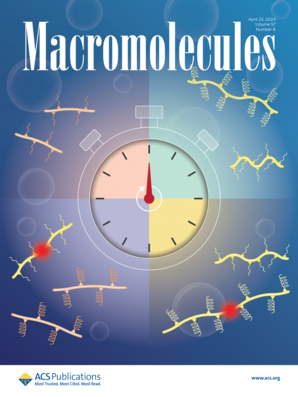Supramolecular Polymer Brushes Grafted via Atom Transfer Radical Polymerization from Surfaces Presenting Non-covalent, Host–Guest Complex-Based Initiators
IF 5.1
1区 化学
Q1 POLYMER SCIENCE
引用次数: 0
Abstract
This paper describes the synthesis of supramolecular polymer brushes via surface-initiated polymerization from adamantane-functionalized initiators that are noncovalently bound to β-cyclodextrin- or cucurbit[7]uril-modified substrates. Surface-initiated atom transfer radical polymerization in aqueous media allowed the growth of various hydrophilic polymer brushes with film thicknesses of up to 40 nm from β-cyclodextrin functionalized surfaces. The adamantane moiety not only forms a host–guest complex with β-cyclodextrin, but also with cucurbit[7]uril, which provides opportunities to study the effect of the binding strength of these supramolecular motifs on the film thickness and grafting density of the resulting polymer brushes. Comparison of supramolecular polymer brushes grown from β-cyclodextrin and cucurbit[7]uril-based noncovalent initiators reveals differences in grafting density that are much smaller than expected based on the differences in the solution binding constant of the corresponding host–guest complexes. Both the β-cyclodextrin as well as the cucurbit[7]uril-anchored supramolecular brushes were remarkably robust toward detachment of the polymer grafts. These observations are attributed to the fact that the rates of formation and dissociation of the host–guest complexes are much faster as compared to diffusion of free, detached polymer chains through the polymer brush film. As a result, the surface-grafted polymer brush presents a steric barrier that prevents detachment of individual chains, and also allows surface-initiated polymerization from substrates to which initiators are bound via putatively weak β-cyclodextrin-based host–guest complexes.

非共价主-客体络合物引发剂表面原子转移自由基聚合接枝的超分子聚合物刷
本文介绍了金刚烷功能化引发剂与β-环糊精或瓜氨酸修饰底物非共价结合,通过表面引发聚合合成超分子聚合物刷。在水介质中,表面引发的原子转移自由基聚合可以从β-环糊精功能化的表面生长出各种亲水性聚合物刷,膜厚可达40 nm。金刚烷部分不仅可以与β-环糊精形成主客体配合物,还可以与葫芦bbbbil形成主客体配合物,这为研究这些超分子基序的结合强度对聚合物刷膜厚度和接枝密度的影响提供了机会。用β-环糊精和葫芦b[7]uril为非共价引发剂生长的超分子聚合物刷体进行比较,发现接枝密度的差异远远小于基于相应的主客体配合物的溶液结合常数的差异。β-环糊精和瓜b[7]小管锚定的超分子刷对聚合物接枝的分离都有显著的稳定性。这些观察结果归因于这样一个事实,即与自由的、分离的聚合物链通过聚合物刷膜的扩散相比,主客体复合物的形成和解离速度要快得多。因此,表面接枝的聚合物刷呈现出一个位阻屏障,可以防止单个链的脱离,并且还允许从底物进行表面引发聚合,引发剂通过假定的弱β-环糊精为基础的主客体配合物结合。
本文章由计算机程序翻译,如有差异,请以英文原文为准。
求助全文
约1分钟内获得全文
求助全文
来源期刊

Macromolecules
工程技术-高分子科学
CiteScore
9.30
自引率
16.40%
发文量
942
审稿时长
2 months
期刊介绍:
Macromolecules publishes original, fundamental, and impactful research on all aspects of polymer science. Topics of interest include synthesis (e.g., controlled polymerizations, polymerization catalysis, post polymerization modification, new monomer structures and polymer architectures, and polymerization mechanisms/kinetics analysis); phase behavior, thermodynamics, dynamic, and ordering/disordering phenomena (e.g., self-assembly, gelation, crystallization, solution/melt/solid-state characteristics); structure and properties (e.g., mechanical and rheological properties, surface/interfacial characteristics, electronic and transport properties); new state of the art characterization (e.g., spectroscopy, scattering, microscopy, rheology), simulation (e.g., Monte Carlo, molecular dynamics, multi-scale/coarse-grained modeling), and theoretical methods. Renewable/sustainable polymers, polymer networks, responsive polymers, electro-, magneto- and opto-active macromolecules, inorganic polymers, charge-transporting polymers (ion-containing, semiconducting, and conducting), nanostructured polymers, and polymer composites are also of interest. Typical papers published in Macromolecules showcase important and innovative concepts, experimental methods/observations, and theoretical/computational approaches that demonstrate a fundamental advance in the understanding of polymers.
 求助内容:
求助内容: 应助结果提醒方式:
应助结果提醒方式:


